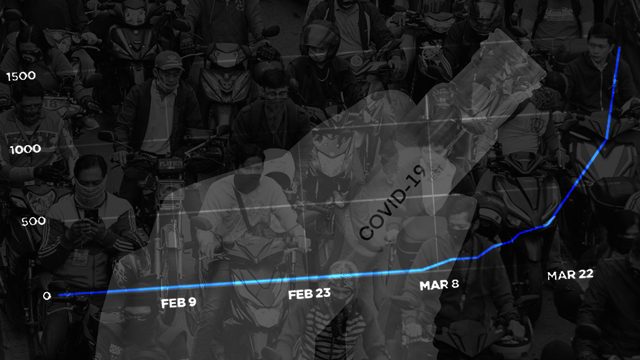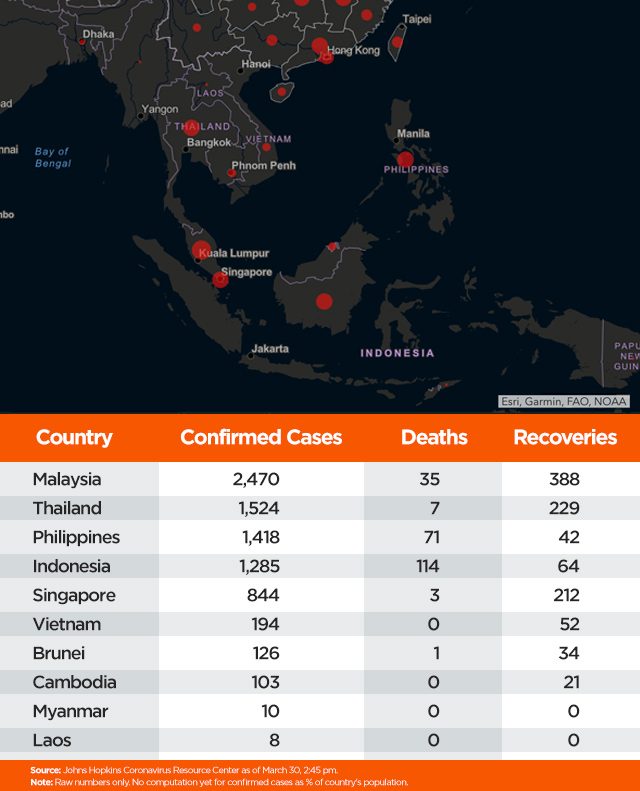SUMMARY
This is AI generated summarization, which may have errors. For context, always refer to the full article.

MANILA, Philippines – On March 22, the Department of Health (DOH) warned there will be an increase in the number of cases they are reporting because testing capacity has increased.
Within that week, on March 28, the number of new confirmed cases in the Philippines increased by a whopping 272 to bring the total to 1,075, up by 34% from the 803 cases the day before.
On Sunday, March 29, it rose further by 343 (a 32% increase from the day before), bringing the total to 1,418.
The next day, Monday, March 30, 128 more were added (or a 9% increase from Sunday), bringing the total to 1,546 cases. (READ: PH coronavirus cases in maps and charts: What the data says)
Does this mean the numbers reported by the health department already reflect the extent of the spread of the disease?
Health experts say no. They noted a number of tell-tale indicators to prove why this is not yet the case.
Testing backlogs
Former health secretary Manuel Dayrit said the number of cases being reported daily is the “picture 7-10 days ago at best,” when you take the period between the onset of symptoms and the confirmation that one is positive for the virus.
He pointed out that the first-ever case in the Philippines – a 38-year-old female from Wuhan, China, where the virus first emerged – became symptomatic on January 21, admitted in San Lazaro hospital on January 25, and was confirmed positive on January 30, according to DOH data. The DOH announced it that same day.
“The infection had already been playing itself out and being contagious from January 21st” until the confirmation was announced, Dayrit told Rappler. “And that plays out all the time for every case that you find.”
He roughly computed that if a “multiplier effect” – a scenario where those who died or those who tested positive had infected others – is considered, there could actually be at least “3,500 or 4,000 cases already” at this point, and even if just 5% of these got seriously ill, “that’s 200 cases all at the same time to fill up now your critical [care] beds.”
In another interview with Rappler on Friday, March 27, Dayrit pointed out that the government’s inter-agency task force pegged the reproductive rate – the number of cases that one confirmed case might infect – at 4. “If we’re assuming that we’re now at 16,000 to 20,000 [infections] today, and if you’re assuming doubling times of every 5 days…we’re going to reach 75,000 in 15 days.”
Dr Maria Elizabeth Mercado, faculty member at the Department of Clinical Epidemiology of the University of Santo Tomas Faculty of Medicine and Surgery and an independent research analyst, likewise said that some of these new cases are probably individuals who got infected a few weeks prior and “just reached the end of their [14-day] inoculation period, and then they just became symptomatic.”
Mercado added that health authorities are able to detect more people now “because we have increased our capacity to test individuals,” given more test kits and additional testing centers.
Exponential growth
As of writing, the Philippines ranked 3rd among ASEAN countries, behind Malaysia (2,470 cases) and Thailand (1,524 cases), according to data from the Johns Hopkins Coronavirus Resource Center.

However, if the pandemic isn’t promptly contained in the Philippines, experts and scientists are seeing various dire scenarios ahead.
The World Health Organization and DOH epidemiologists earlier estimated that in the Philippines, the number of coronavirus cases could peak to 75,000 by June unless proper interventions are put into place.
Data scientists Erika Legara and Christopher Monterola of the Asian Institute of Management (AIM) also computed that infections could grow to 26,000 cases by the end of March if the virus’ random spread is not contained.
Dr Darwin Bandoy of the College of Veterinary Medicine at the University of the Philippines Los Baños (UPLB) likewise projected that if COVID-19 spirals out of control, there could be 245,000 new cases in one day by end-June, and that the spread won’t taper off until the month of October – about 6 months from now.
In Metro Manila, where most cases are concentrated, the number could peak to 2,500 cases by mid-April, if interventions such as the enhanced community quarantine aren’t effective enough, said UPLB professor Jomar Rabajante.
Improving, enforcing quarantine regulations
Given these projections, experts emphasize the need to exert all efforts to “flatten the curve” or lessen the spread of the coronavirus. (IN NUMBERS: What hospitals need to treat COVID-19 patients)
Health authorities ask the public to wash and sanitize their hands regularly, maintain physical distance from people, practice proper coughing and sneezing etiquette, stay far from infected/sick people and wear masks when taking care of them, and seek medical care as early as possible when exhibiting symptoms of the virus like fever, cough, or difficulty in breathing.
Dayrit said the government “will have to figure out what we’re going to do at the end of this community quarantine period, given what the numbers are telling us.”
The government placed Metro Manila under lockdown from March 15 to April 14, and Luzon from March 17 to April 12. These may be extended further or lifted earlier, depending on the situation.
Dayrit also said he hopes that testing backlogs could be cleared and more tests could be conducted “so that the cases that we’re reporting…would provide us an even more accurate picture, even if late.”
In addition, he emphasized the importance of social or physical distancing, or preventing the virus from moving from one infected person to another. “Because a person who’s been infected, if he doesn’t pass it on, you won’t get any more cases. The infection can either kill that person, make him mildly ill, or not affected at all.”
Mercado also said that if people stick to social distancing guidelines and limit their outdoor activities, “hopefully, by the 3rd week of the lockdown, the number of PUIs [patients under investigation] or PUMs [persons under monitoring] would somehow go down.”
“For me, that’s the first indication that we are getting this a bit [under] control,” she added. “Then eventually, when we have lesser PUIs and PUMs, we’ll probably see a reduction in the number of new cases being reported.”
Dayrit also noted that in places where physical distancing would be difficult to do, the next line of defense is mitigation. “Because social contact is almost impossible to implement, particularly in urban poor areas, you can only rely now on heightened surveillance and identification of places for quarantine.”
Since there are cases now in the provinces, Dayrit said he hopes local governments are implementing more stringent contact tracing and crafting containment measures “so that the infection doesn’t grow there.”
Public health experts also stressed the need to improve testing strategies to help government measure the extent of the outbreak and the effectiveness of responses to the pandemic. – Rappler.com
Add a comment
How does this make you feel?





There are no comments yet. Add your comment to start the conversation.